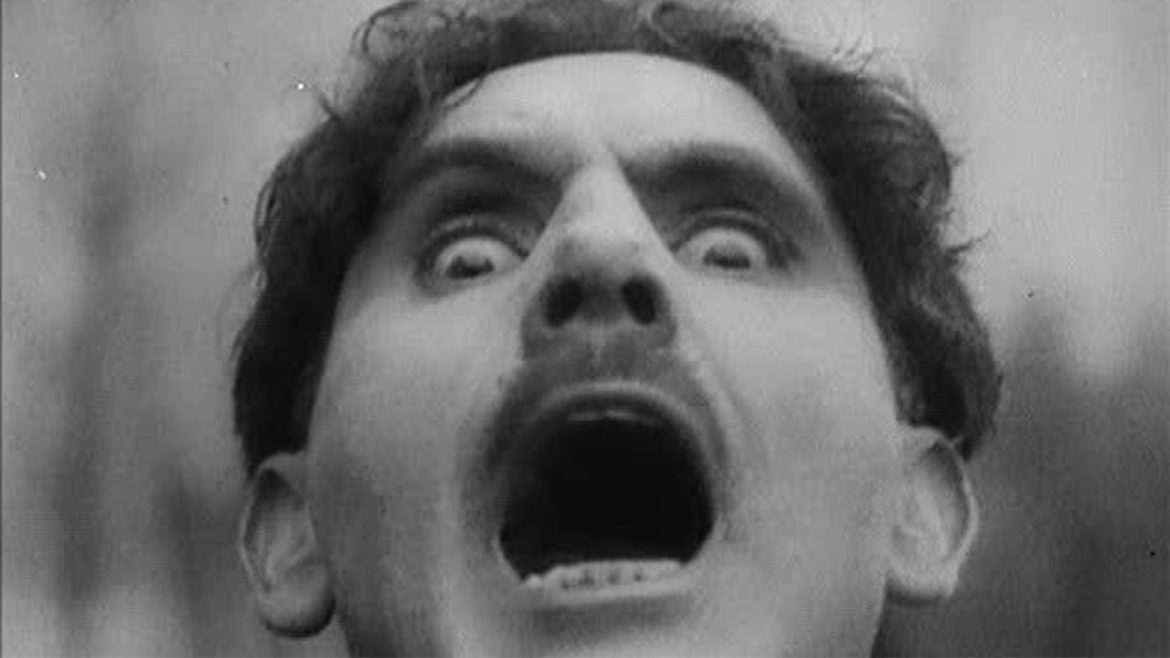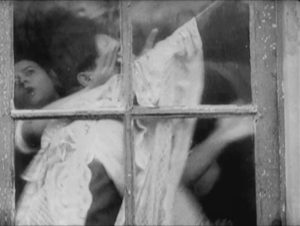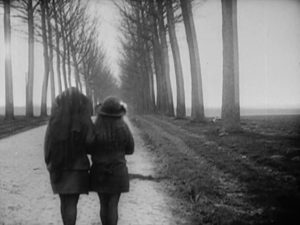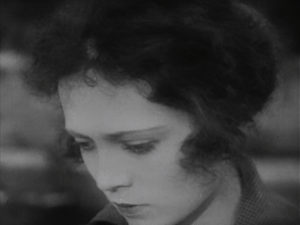Delicate curtains flutter inside a home’s open window. Suddenly, a woman’s frightened face appears behind them, an assailant trailing. The doorknob turns frantically. The door finally opens and the woman emerges. The scene repeats and a similarly terrified man emerges. We cut to the crazed face of the man chasing them both. The man and woman are thrashed in turn, continuity falling by the wayside. An ominous axe leans against the house. Quick cuts to: the woman’s bloodied face; the man, head tilted back in open-mouthed horror; the axe raised aloft. Relatively longer shots: barren trees in the distance, the axe thrown into a puddle of mud and rainwater; the open door to the house and the mess left behind; a fire still burning in the hearth. Finally, a haunting cut to two young girls playing happily in the woods with a kitten.
It’s a remarkably violent, explosive, and highly stylized opening sequence, through which the Soviet-French director Kirsanoff conveys a surprising amount of information in less than a minute. Typical of his style, however, and characteristic of the rest of the film, it’s very much up to the audience to determine how these pieces of information fit in Ménilmontant.
An odd, elliptical, elegiac film – a classic melodrama starring Kirsanoff’s wife and muse Nadia Sibirskaia, bookended by acts of shocking violence – Ménilmontant remains largely overlooked (despite its apparent status as Pauline Kael’s favorite movie). A closer look reveals its status not just as a work of art, but as a fascinating window into conflicting and evolving elements of the period’s cinematic avant-garde.
Of course, “avant-garde” is a notoriously nebulous term. In this context, it joins together Kirsanoff, generally associated with French Impressionism, with artists as diverse as Man Ray, Hans Richter, Marcel Duchamp, Fernand Léger, and Jean Epstein (all of whom, among others, are included on Kino’s “Avant-Garde: Experimental Cinema of the 1920s and ‘30s”). This is counter-intuitive: Kirsanoff’s focus on narrative, however oblique, is worlds apart from Dadaist pure cinema, the Surrealists’ scorn for anything resembling the “bourgeois trappings” of story and character, or the Futurists’ single-minded fascination with technology and movement for its own sake. Poet Robert Desnos claimed the unifying strands were “[A]n exaggerated respect for Art, a mysticism of expression … standing out because of its production’s speed, its absence of any human emotion and the danger it represents to all the rest of the movie industry.” But only the first three qualifiers really characterize Ménilmontant.
Kirsanoff’s avant-garde bonafides mostly arise from general association and from operating outside of the governing systems, self-funding projects that allowed for freer experimentation. Ménilmontant draws liberally from multiple new sources – especially wedding Eisenstein’s Soviet theories of the montage and “conflict” to aspects of the French auteurs’ focus on subjective experience – but also reaches back to much older, standard melodrama.
After Ménilmontant’s brazen opening, we enter into a narrative recognizable to anyone familiar with Pabst or von Sternberg. Without a single title card – and there are, impressively, none to be found at all throughout Ménilmontant, all information conveyed either through image or carefully incorporated words in the mise-en-scene, like “To My Father” and “To My Mother” on a tombstone – we gather that the murdered adults were parents to the two young girls. The crime itself is never explained, leaving a sense of unease that haunts the film, and is only resolved in its conclusion by a parallel, and similarly ambiguous, act of violence. The children are glimpsed walking down an empty, tree-lined street in a series of elegant dissolves, and an overgrown graveyard marks the passage of time.
We next catch up with them in the working-class neighborhood of Paris that gives the film its title. Perhaps a decade has passed, and the two eke out a living making artificial flowers while sharing an apartment. As in most melodrama, a man comes between them: in this case, a womanizer who seduces Sibirskaia, the younger of the two. A sexually frank sequence finds her in his apartment, where the two flirt and touch fleetingly, before an Eisensteinian montage of cityscapes and traffic stand in for their actual sex. (Even such Futurist touches are deployed by Kirsanoff in the service of narrative.) Some critics have implied that Sibirskaia’s character is raped instead, but there’s little reason to think so from the text, despite that being a frequent enough trope: in fact, Kirsanoff’s camera adores her face and movements, all of which imply innocence and coyness (fidgeting with her leg, turning her back, stealing a quick kiss with a smile). The clanging montage might indicate an innocence lost, the country girl now fully citified, but there’s not much to suggest an attack on her lover’s part.
In any case, she finds herself eventually abandoned and, to make matters worse, observes her ex-lover seducing her own sister, who we have previously glimpsed waiting in vain for her return. To make worse matters even more dire, we cut to Sibirskaia entering a maternity ward. We are now firmly in the realm of conventional melodrama, informed by Kirsanoff’s array of in-camera tricks, quick editing, and poetic eye.
The realist narrative – the seduced and abandoned single mother fending for herself in the ambivalent city – continues to butt up against Kirsanoff’s impressionist sensibilities. A long sequence cuts between Sibirskaia cradling her baby, her face full of despair, and the waters of the Seine. (Kirsanoff adores water: in one of several startling superimpositions, her face and the Seine share the same space on film, implying her thoughts of an uncanny merger between the two.) Is she contemplating suicide? Child-murder? Both? The subjective emphasis is clear, even if the exact details aren’t, and for an agonizing minute – and eternity by the standards of Ménilmontant – we hold our breath.
She decides against it (whatever “it” was, precisely), and we find her on a public park bench. In a deeply humanist scene that Chaplin must’ve admired – and that Pauline Kael surely did, too – an old man quietly and without eye contact shares a piece of bread and salami with her. The simple act of kindness brings her to silent tears.
Ménilmontant closes with a reunion of the two estranged sisters, the older of whom now appears to work as a prostitute outside of a seedy motel. Glimpsing her nephew for the first time, the elder embraces the younger, suggesting that the bonds of sisterhood are stronger than the nefarious and patriarchal forces of the modern city. In case there’s any lingering doubt, the film’s final moments showcase another brutal sequence, as the young man is bludgeoned and beaten by two previously unseen attackers (a woman and a man, in an inversion of the film’s opening). As viewers, we could surmise that he is a pimp or a crook, in context, but the narrative is open-ended. Perhaps this is an attack as random as the parents’ murder, or perhaps he simply has callously used one too many women in Ménilmontant.
What’s most interesting, though, is the existence of a narrative at all. While Kirsanoff’s film shares much with the art films being made at the same time, and draws heavily on the dynamism of his homeland’s montage technique, Ménilmontant grounds the experimentation in something approaching melodramatic realism, at least by avant-garde standards. The film should be better known, if for no other reason than the contributions Kirsanoff makes to bridging the gap between early and later experiments in form.
As for Kael’s admiration, it’s not hard to imagine why. When she wrote, in “Trash, Art and the Movies”, that “for the greatest movie artists … there is a unity of technique and subject,” she may very well have had Ménilmontant in mind.
Of course, in the same essay, Kael wrote:
Simply to be enjoyable, movies don’t need a very high level of craftsmanship: wit, imagination, fresh subject matter, skillful performers, a good idea – either alone or in any combination – can more than compensate for lack of technical knowledge or a big budget.
Despite Kirsanoff’s own protestations (“knowing nothing” about film technique), the low-budget Ménilmontant is clearly not lacking in craftsmanship. But it’s in the areas of imagination, skill, performance, and the newness of its narrative and aesthetic configurations that it most stands out.





